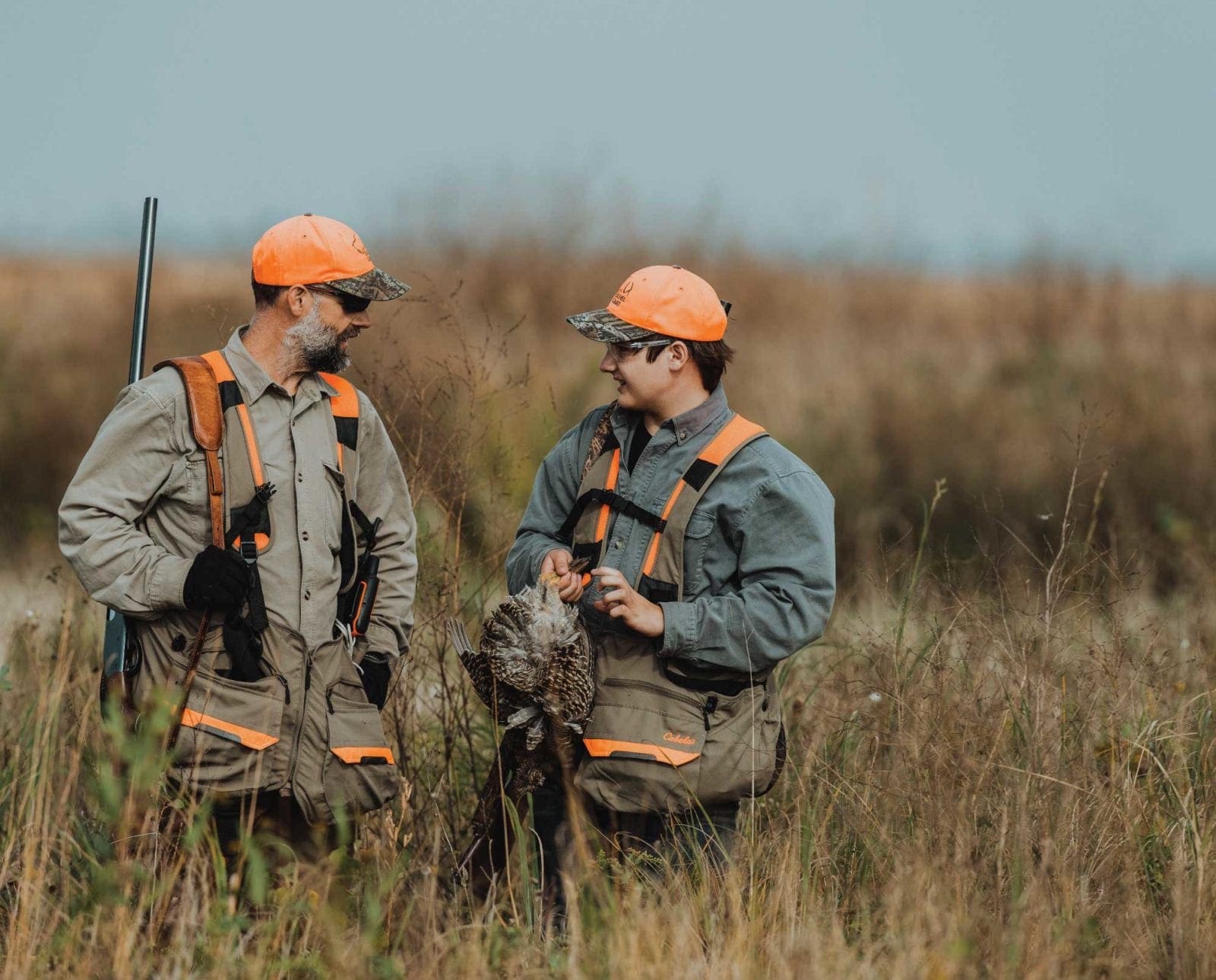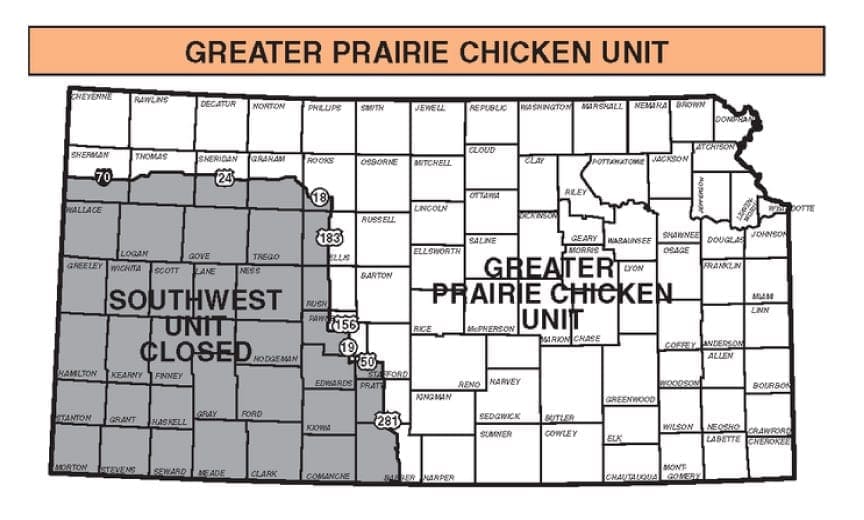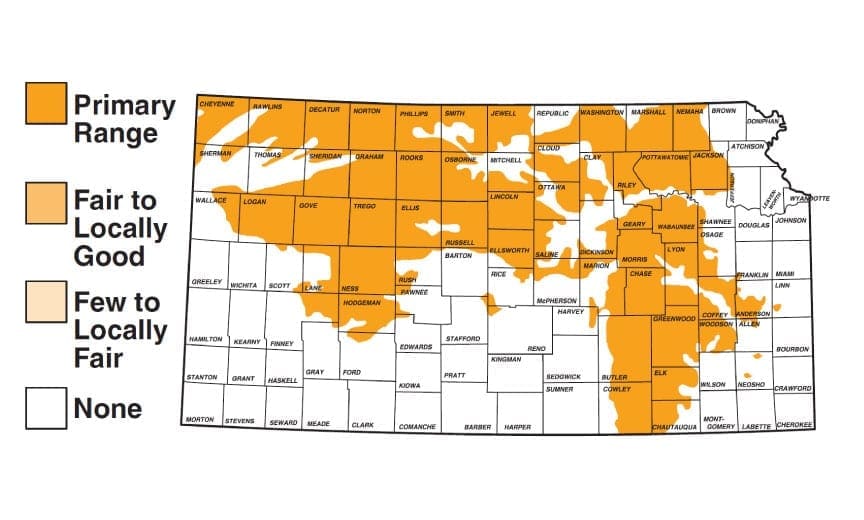Home » Grouse Species » Prairie Chicken Hunting » Hunting Prairie Chickens in September – The Kansas “Grouse” Opener
Hunting Prairie Chickens in September – The Kansas “Grouse” Opener

Edgar Castillo is a recently retired law enforcement officer for…
Mix up your early season with prairie chicken in Kansas
During the month of September bird hunters are doing one of two things: hunting doves or some type of grouse, albeit blue, spruce, sharp-tailed, or the ever so popular “King of the Birds,” the ruffed grouse. But let’s not forget those of us who reside in Kansas who have the opportunity to hunt that other grouse, the prairie chicken. States that currently hold open prairie chicken seasons include Kansas, Colorado, Nebraska, Minnesota, North Dakota and South Dakota. By far the largest populations of greater prairie chickens occur in Kansas and Nebraska.
The Kansas Prairie Chicken Season
The greater prairie chicken season is split into two parts. Hunting for the greater prairie chicken is only allowed in the designated East Unit (see map). Each season provides the upland bird hunter with a distinct manner to hunt the iconic bird. The early portion of the greater prairie chicken season runs from September 15 to October 15. The regular prairie chicken season reopens on the third Saturday of November and ends January 31 of the following year.
The Southwest Unit is closed to all prairie chicken hunting (lesser and greater). The U.S. Fish and Wildlife Service added the lesser prairie chicken to the Threatened Species List in 2014, so prairie chicken hunting is not allowed in that part of the state (see map). Both species overlap in this area of Kansas. This ensures that hunters do not misidentify and shoot the wrong species of prairie chicken.

Daily Bag Limit is two; the Possession Limit is eight prairie chickens.
Permit. All prairie chicken hunters are required to purchase a $2.50 Prairie Chicken Permit in addition to a regular Kansas hunting license. The permit allows hunter and harvest activity and data to be measured to improve management activities and determine policy decisions.
Identification of Prairie Chickens
Once your dog gets “birdy” and you move closer until you’re greeted by a staggered flush of several chickens — then you pick out a bird and pull the trigger — you’ll need to identify the downed bird to determine sex. Tympanuchus cupido or prairie chicken is a stocky chicken-like grouse with a short round tail. Both male and female prairie chickens are barred brown-and-white, with the male being slightly larger.
Other distinguishing features include the yellow, almost orange-colored comb over the eyes of the males or “boomers” as they’re called. Males possess an orange neck patch and long, dark head feathers, called pinnae. These pinnae flare and resemble horns during the male’s elaborate courting displays in the spring.
Prairie chickens can be identified in flight, as they fly using a strange combination of rapid wing beats followed by a long glide.
Read: How to Identify the Difference in Prairie Grouse on the Hunt
Habitat and Distribution of Prairie Chickens in Kansas
Greater prairie chickens can be found in a variety of habitats. However, these prairie grouse rely upon large tracts of undisturbed tallgrass prairie. Like the name implies, prairie chickens live in areas of open prairie and savannah where they can feed on leaves, seeds, grains, and insects. Prime habitat is where prairie is intermixed with oak woodland, to include habitat interspersed with agricultural fields.
The traditional Kansas stronghold for greater prairie chickens is the Flint Hills, a roughly 50-mile wide band of tallgrass prairie that extends from the Oklahoma border northward nearly to the Nebraska line in the eastern third of the state.
Strong prairie chicken populations also exist in the mixed prairies of the Smoky Hills in north central Kansas. There are significant numbers of prairie chickens which can be found in the grassland breaks that parallel the streams of the northwest and west central portion of Kansas.

Early Season Tactics for Prairie Chickens
During the early season prairie chickens are not flocked up but rather scattered widely across the rolling Kansas green prairie. Hunters are more likely to encounter singles or small groups of chickens.
The early season allows hunters to utilize pointing dogs due to the tendency for young chickens to hold well. However, that’s not always the case. Hunting for early season chickens is to hunt behind both medium and big, ranging, pointing dogs. Dogs should sweep across the prairie in search mode, ever waiting for that smell of chickens to waft across their scent cone.
Hunters will realize that there’s a lot of prairie ground to cover and relatively few chickens. The terrain encountered may consist of big hills that stretch as far as the eye can see. Kansas has several regions with hills that resemble ripples of green below a blue prairie sky. A good pair of boots and adequate supply of water are necessary during the early prairie chicken season. When dogs do catch a break and freeze instantly on point and hunters move in for the flush, shots will be taken at long distances that could be measured in miles.
During the early season, prairie chickens feed mostly on the abundant insects found thriving on the prairie. Pastures of green rolling grasslands can be daunting for the hunter who seeks to find chickens in a sea of vastness. When hunting tracts with hills, bird hunters should focus on targeting the shady side of hills. During September and even into October, days can become hot. After feeding, birds will move into these shady spots where they loaf. Stands and patches of red sumac are also good sources of shade and food.
Many times I’ve walked directly to patches or clumps of sumac only to have chickens flushed. Hunters should pay attention to spots where chickens are observed, as birds will frequently inhabit the same general spots year after year.
Shotguns, Chokes, and Shells for Prairie Chickens
Although chickens are known to hold better during the early season, shots can be long. Young of the year birds are not heavily feathered as they will be later in the year, which means chickens are not particularly hard to kill and fold when hit with a string of pellets. Prairie chickens tend to not run like their cousin, the ring-neck pheasant. A good choice of shotgun for the prairie may consist of a 12-, 16-, or 20-gauge with an improved cylinder or modified choke. Shot shells in sizes 4 to 6 get the job done.
Conservation Issues Surrounding Prairie Chickens
The prairie chicken’s plight appears to be similar to that of the sage grouse. Habitat. Maintaining extensive tracts of open, well-managed prairie is critical to the conservation of both the greater and lesser prairie chicken. Kansas public lands constitute a mere three percent, whereas the other 97 percent of the land is privately owned. What does that mean? It means private landowners, farmers, and ranchers are the most important stewards of the prairies. Alliances made between conservation organizations, state agencies and the private sector are the only way to save the prairie chicken and ensure their continued survival and opportunity for hunters to chase Kansas grouse on the prairies.
Edgar Castillo is a recently retired law enforcement officer for a large Kansas City metropolitan agency. He also served in the United States Marine Corps for twelve years. Edgar longs for the colors of autumn and frosty, winter days so he can explore the landscapes in search of wild birds in wild places. His passion lies in the uplands as he self-documents his travels across public lands throughout Kansas hunting open fields, walking treelines, & bustin’ through plum thickets.





Good stuff Edgar. I’m planning to get out there soon.
Thanks! Let me know when you do.
Brilliant work. As always, and incredible read.
Thanks Bill! I just wish I was a little more successful…they are tough birds to hunt.
Good article. Grass is really tall this year after all the rains so hunting is a challenge this year.
We’ve had quite a bit of rain in Kansas this year, making finding areas conducive to chickens a bit more difficult.
Great article!!!
Alex, thanks for the kind words! I hope it provided you with some info or inspires you to chase prairie chickens.